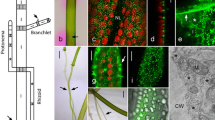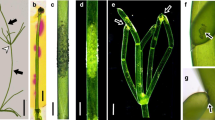Summary
Charasomes, complex membrane structures, were found along the longitudinal walls of internodal and lateral branch cells ofChara corallina andC. braunii, but not along their transverse walls or in other cell types. Charasome-complexes were larger and more numerous in the lateral branch cells than in internodal cells. InC. corallina, a dioecious species, especially large elaboration of charasome material occurs in the lateral branch cells of the female plant, sometimes reaching a cross-sectional width which is as great as that of the adjacent cell wall.
Chara internodes transport hydroxyl (OH−) out of the cell and bicarbonate (HCO3 −) into the cell. Spatial distribution of charasomes along the cell was examined with respect to these transport phenomena, which occur at specific identifiable regions along the cell. Charasome-complexes were always found in regions in which HCO3 − transport occurs but were often fewer, reduced in size or absent in areas of OH− efflux.Nitella flexilis exhibited similar patterns of OH− and HCO3 − transport along the cell; however, there was a complete absence of charasomes. Ultrastructural examinations onNitella translucens indicated that charasomes were also absent in this species. The observation that charasomes are present in both transport regions ofChara but are totally lacking in the twoNitella spp. indicates that the charasome-complex is not involved in transport of either substance. Other possible functions for the charasomes, including a role in osmoregulation, are discussed.
Charasome substructure is the same in bothChara species, consisting of a mass of short (50 nm average length) anastomosing tubules (30 nm average diameter) derived from the plasmalemma. The interior of the tubules is open to the cytoplasm while the area surrounding the tubules is ultimately open to the wall and thus can be considered to be wall space. Charasomes are quite variable in size and shape, but are roughly globular, with the bulk of the structure projecting into the cell cytoplasm. Tubular components of the charasome were sometimes seen to extend into the microfibrillar wall matrix. A three dimensional model of the charasome-complex presented details the great complexity of this membrane system.
Similar content being viewed by others
References
Barton, R., 1965 a: An unusual organelle in the peripheral cytoplasm ofChara cells. Nature205, 201.
—, 1965 b: Electron microscope studies on surface activity in cells ofChara vulgaris. Planta66, 95–105.
—, 1968: Autoradiographic studies on wall formation inChara. Planta82, 302–306.
Bracker, C. E., 1967: Ultrastructure of fungi. Ann. Rev. Phytopath.5, 343–374.
Crawley, J. C. W., 1965: A cytoplasmic organelle in association with the cell walls ofChara andNitella cells. Nature205, 200–201.
Ducreux, G., 1975: Corrélations et morphogenése chez leChara vulgaris L. cultivéin vitro. Rev. gén. Bot.82, 215–357.
Edwards, M. R., 1962: Plasmalemma and plasmalemmasomes ofListeria monocytogenes. 8th Int. Congr. Microbiol., Montreal. Abst., p. 31.
Ferrier, J. M., Lucas, W. J., 1979: Plasmalemma transport of OH− inChara corallina. II. Further analysis of the diffusion system associated with OH− efflux. J. exp. Bot.117, 705–718.
Fischer, R. A., Dainty, J., Tyree, M. T., 1974: A quantitative investigation of symplasmic transport inChara corallina. I. Ultrastructure of the nodal complex cell walls. Can. J. Bot.52, 1209–1214.
Kamiya, N., Kuroda, K., 1956: Artificial modification of the osmotic pressure of the plant cell. Protoplasma46, 423–436.
LaClaire II, J. W., West, J. A., 1979: Light and electron-microscopic studies of growth and reproduction inCutleria (Phaeophyta). II. Gametogenesis in the male plant ofC. hancockii. Protoplasma101, 247–267.
Lucas, W. J., 1976: Plasmalemma transport of HCO3 − and OH− inChara corallina: nonantiporter systems. J. exp. Bot.27, 19–31.
—,Ferrier, J. M., Dainty, J., 1977: Plasmalemma transport of OH− inChara corallina. Dynamics of activation and deactivation. J. Membrane Biol.32, 49–73.
-Nuccitelli, R., 1980: HCO3 − and OH− transport across the plasmalemma ofChara: spatial resolution obtained using extracellular vibrating probe. Planta (submitted for publication).
—,Smith, F. A., 1973: The formation of alkaline and acid regions at the surface ofChara corallina cells. J. exp. Bot.24, 1–14.
Marchant, R., Moore, R. T., 1973: Lomasomes and plasmalemmasomes in fungi. Protoplasma76, 235–247.
—,Robards, A. W., 1968: Membrane systems associated with the plasmalemma of plant cells. Ann. Bot.32, 457–471.
Moore, R. T., McAlear, J. H., 1961: Fine structure ofMycota. 5. Lomasomes—previously uncharacterized hyphal structures. Mycologia53, 194–200.
Nakagawa, S., Kataoka, H., Tazawa, M., 1974: Osmotic and ionic regulation inNitella. Plant Cell Physiol.15, 457–468.
Pate, J. S., Gunning, B. E. S., 1972: Transfer cells. Ann. Rev. Plant Physiol.23, 173–196.
Spanswick, R. M., Costerton, J. W. F., 1967: Plasmodesmata inNitella translucens: structure and electrical resistance. J. Cell Sci.2, 451–464.
Spurr, A. R., 1969: A low-viscosity epoxy resin embedding medium for electron microscopy. J. Ultrastruct. Res.26, 31–43.
Sundberg, I., Lembi, C. A., 1976: Phosphotungstic acid-chromic acid: a selective stain for algal plasma membranes. J. Phycol.12, 48–54.
Walker, N. A., 1976: Transport of solutes through the plasmodesmata ofChara nodes. In: Intercellular communication in plants: studies on plasmodesmata (Gunning, B. E. S., Robards, A. W., eds.), pp. 165–199. Berlin-Heidelberg-New York: Springer.
—, 1980: The transport systems of charophyte and chlorophyte giant algae and their integration into modes of behavior. In: Plant membrane transport: current conceptual issues (Spanswick, R. M., Lucas, W. J., Dainty, J., eds.), pp. 287–304. Amsterdam: Elsevier North Holland.
Author information
Authors and Affiliations
Rights and permissions
About this article
Cite this article
Franceschi, V.R., Lucas, W.J. Structure and possible function(s) of charasomes; complex plasmalemma-cell wall elaborations present in some characean species. Protoplasma 104, 253–271 (1980). https://doi.org/10.1007/BF01279771
Received:
Accepted:
Issue Date:
DOI: https://doi.org/10.1007/BF01279771




